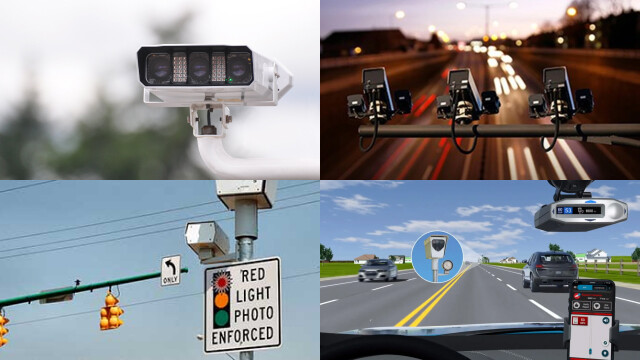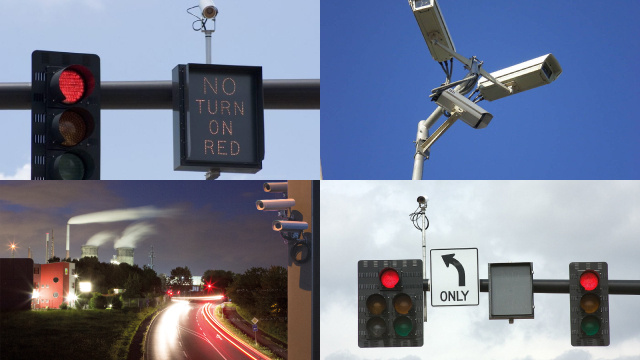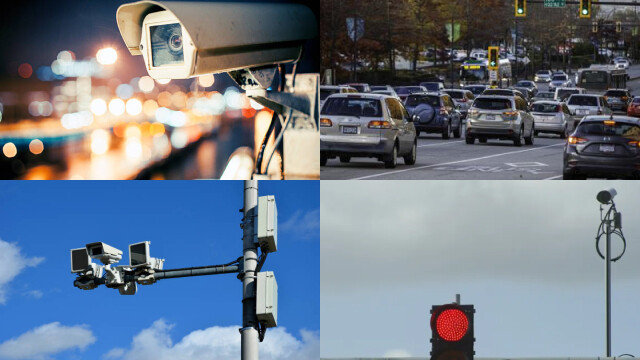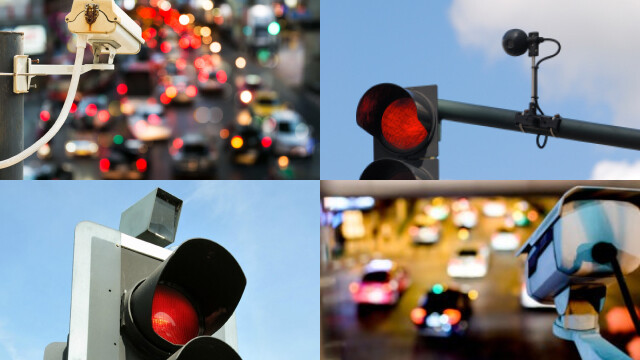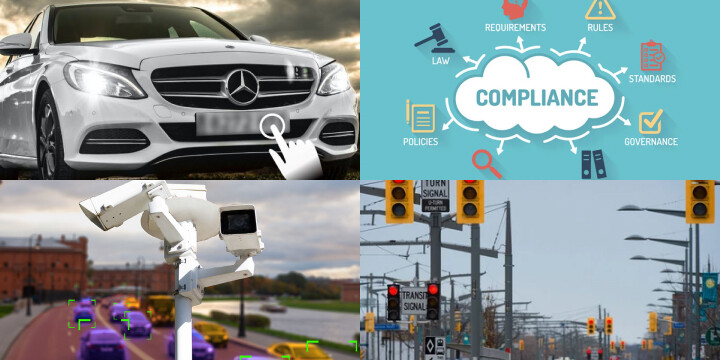Understanding Traffic Camera Systems: A Brief Overview
Traffic camera systems play a crucial role in monitoring and managing traffic flow on roads and highways. Here’s a concise overview of these systems:
- Camera Placement: Traffic cameras are strategically installed at key locations to capture real-time footage of road conditions, intersections, and traffic patterns. They provide valuable data for traffic management and safety purposes.
- Purpose and Functionality: Traffic cameras help monitor traffic congestion, detect accidents or incidents, enforce traffic laws, and aid in emergency response. They assist authorities in making informed decisions regarding traffic control and improving overall road safety.
- Live Streaming and Recording: Many traffic cameras provide live streaming of footage, allowing authorities and the public to view real-time traffic conditions. Additionally, the cameras often record video footage that can be reviewed later for analysis or investigation purposes.
- Privacy Considerations: While traffic camera systems serve important purposes, privacy concerns can arise. Balancing the benefits of enhanced road safety with individual privacy rights is crucial when implementing and utilizing these systems.
Understanding the basics of traffic camera systems enables us to appreciate their role in monitoring traffic and enhancing road safety. However, it’s important to address privacy concerns and ensure responsible usage of the captured footage.
Method 1: Contacting Local Traffic Authorities for Access
If you’re looking to access traffic camera footage, reaching out to local traffic authorities is often the first step. Here’s how you can go about it:
- Identify the Relevant Authority: Research and identify the specific local traffic authority responsible for managing the traffic camera network in your area. This could be a city or county transportation department, highway patrol, or a dedicated traffic management agency.
- Contact Information: Locate the contact information for the relevant authority. This may be available on their official website, through a phone directory, or by reaching out to the local government offices.
- Formal Request: Contact the traffic authority and inquire about the procedure for accessing traffic camera footage. They may require you to submit a formal request, specifying the date, time, and location of the footage you are interested in.
- Cooperation and Compliance: Cooperate with the authority’s guidelines and provide any necessary information or documentation they require. Respect any privacy or legal considerations they may have in place.
By contacting local traffic authorities and following their established procedures, you can increase your chances of gaining access to the traffic camera footage you need for personal or informational purposes.
Method 2: Exploring Online Platforms for Publicly Available Footage
When seeking access to traffic camera footage, exploring online platforms can be a valuable approach. Consider the following steps:
- Research Publicly Available Platforms: Conduct research to identify online platforms that provide access to publicly available traffic camera footage. These platforms may include official websites of transportation departments, traffic management agencies, or public safety organizations.
- Check Local Government Websites: Many local governments provide access to live or archived traffic camera footage through their official websites. Look for dedicated sections or web pages related to traffic management or public safety.
- Traffic Monitoring Apps: Explore traffic monitoring apps that aggregate live traffic camera feeds from various sources. These apps often provide real-time footage and allow users to view different camera locations.
- Verify Legitimacy: Ensure that the platforms you utilize are legitimate and authorized sources. Use official websites or reputable apps to avoid potential security risks or unreliable information.
By exploring online platforms that offer publicly available traffic camera footage, you can conveniently access real-time or archived footage, gaining valuable insights into traffic conditions and making informed decisions regarding your commute or travel plans.
Method 3: Filing a Public Records Request for Traffic Camera Footage
If you are unable to access traffic camera footage through online platforms or direct contact with local traffic authorities, you can consider filing a public records request. Here’s how you can proceed:
- Research Public Records Laws: Familiarize yourself with the public records laws in your jurisdiction. These laws outline the process for requesting access to government-held information, including traffic camera footage.
- Identify the Relevant Agency: Determine the agency or department responsible for managing the traffic cameras. This could be a local government entity or law enforcement agency.
- Draft the Request: Prepare a formal request letter specifying your intention to obtain traffic camera footage. Include relevant details such as the date, time, and location of the footage you are seeking.
- Submit the Request: Send the request to the designated contact within the agency or department. Ensure that you provide accurate contact information for them to respond to your request.
- Follow Up: Be patient as public records requests may take time to process. If necessary, follow up with the agency to check the status of your request and provide any additional information they may require.
Filing a public records request for traffic camera footage is a legal avenue to access such information. However, it is essential to comply with the applicable laws and regulations governing public records requests in your jurisdiction.
Important Considerations: Privacy and Legal Implications
When accessing traffic camera footage, it’s crucial to be aware of the privacy and legal implications involved. Here are some key considerations to keep in mind:
- Privacy Laws: Familiarize yourself with privacy laws and regulations in your jurisdiction. Understand how these laws govern the collection, storage, and use of personal information captured by traffic camera systems.
- Purpose of Use: Ensure that your request for traffic camera footage aligns with a legitimate purpose, such as research, public safety, or personal information verification. Misuse or unauthorized distribution of the footage may result in legal consequences.
- Anonymization and Blurring: If sharing traffic camera footage publicly, consider anonymizing or blurring identifying details to protect the privacy of individuals captured in the footage.
- Consent and Notice: In some cases, obtaining consent or providing notice to individuals captured in the footage may be required by law. Understand the legal requirements and follow appropriate procedures when necessary.
- Responsible Data Handling: Handle any obtained footage responsibly, ensuring that it is stored securely and used only for its intended purpose. Adhere to data protection practices to safeguard the privacy and security of the footage.
By being mindful of privacy laws, adhering to legal requirements, and responsibly handling traffic camera footage, you can mitigate privacy concerns and avoid potential legal implications. Respecting privacy rights while utilizing this data is essential for maintaining a balance between public interest and individual privacy.
Tips for Locating and Accessing Traffic Camera Networks
Locating and accessing traffic camera networks can be beneficial for monitoring road conditions and planning your commute. Consider the following tips to help you in this endeavor:
- Research Local Traffic Authorities: Start by researching the local traffic authorities responsible for managing traffic camera networks in your area. Visit their websites or contact them directly to inquire about available camera locations and access options.
- Check Transportation Department Websites: Many transportation departments maintain websites that provide information on traffic conditions, including access to live camera feeds. Explore these websites to locate camera networks and check for any available public access.
- Use Traffic Apps and Websites: Traffic monitoring apps and websites often aggregate data from various sources, including traffic camera networks. Install reputable apps or visit reliable websites to view live or recorded camera footage for your desired locations.
- Follow Social Media Channels: Local traffic authorities or news outlets often share updates and live feeds from traffic cameras on their social media channels. Follow these channels for real-time information and access to camera networks.
- Collaborate with Commuter Communities: Engage with online commuter communities or forums where fellow commuters share information about traffic camera networks. They may provide insights, tips, or access to lesser-known camera feeds.
Enhancing Your Search: Utilizing Traffic Monitoring Apps and Websites
To stay updated on real-time traffic conditions and gain access to traffic camera footage, utilizing traffic monitoring apps and websites can significantly enhance your search. Consider the following tips:
- Install Reliable Traffic Apps: Look for reputable traffic monitoring apps that provide live updates on road congestion, accidents, and construction. These apps often integrate traffic camera feeds, allowing you to view real-time footage and make informed decisions about your route.
- Explore Official Transportation Websites: Many transportation departments maintain official websites that offer traffic information and access to live camera feeds. Visit these websites to find valuable resources, including maps, traffic alerts, and direct links to camera networks.
- Check Local News Websites: Local news websites often provide traffic updates and access to traffic camera footage. Look for dedicated sections or features that focus on traffic conditions in your area.
- Consider Community-Sourced Platforms: Some websites or online communities allow users to contribute traffic information, including sharing camera footage. Explore these platforms for additional camera locations or different perspectives on traffic conditions.
Alternatives to Official Sources: Crowd-Sourced Traffic Camera Footage
In addition to official sources, crowd-sourced traffic camera footage can provide valuable insights into real-time traffic conditions. Consider the following alternatives to access such footage:
- Social Media Platforms: Check social media platforms for community groups or accounts dedicated to sharing traffic updates. These platforms often feature user-contributed traffic camera footage from various locations, offering a diverse range of perspectives.
- Traffic Monitoring Apps with User Contributions: Some traffic monitoring apps allow users to submit and share their own traffic camera footage. These contributions enhance the available coverage and provide additional viewpoints beyond official sources.
- Online Forums and Communities: Participate in online forums or communities where fellow commuters discuss traffic conditions. Members often share links or footage from lesser-known traffic cameras, offering unique angles and perspectives.
- Local Traffic Updates Websites: Explore websites dedicated to local traffic updates and user-contributed content. These platforms may feature user-submitted traffic camera footage, expanding the available sources beyond official channels.
By leveraging crowd-sourced traffic camera footage, you can access a broader range of camera locations and viewpoints. However, keep in mind that the accuracy and reliability of these sources may vary, so it’s essential to cross-reference information and exercise discretion when relying on crowd-sourced footage.
Safeguarding Your Privacy: Best Practices for Using Traffic Camera Footage
Using traffic camera footage for various purposes, such as monitoring road conditions or planning commutes, can be valuable, but it also raises privacy concerns. Here are some best practices for using traffic camera footage while respecting privacy:
- Focus on Public Spaces: Traffic cameras are typically installed in public areas to monitor road conditions, not private spaces. Avoid using traffic camera footage to intrude on people’s privacy in their homes or private property.
- Blur Faces and License Plates: If you plan to share or publish traffic camera footage, take the time to blur identifiable information like faces and license plates. This helps protect individuals’ identities.
- Use Footage Responsibly: Only use traffic camera footage for its intended purpose, such as checking traffic conditions or monitoring road safety. Avoid using it for any malicious or invasive purposes.
- Comply with Local Laws: Research and understand the laws and regulations in your region regarding the use of traffic camera footage. Laws may vary, so ensure you are in compliance.
- Secure Your Own Cameras: If you install your own traffic cameras, position them in a way that minimizes intrusion into private spaces. Ensure your cameras capture only what is necessary for their intended purpose.
- Limit Sharing: Be cautious about sharing traffic camera footage on social media or other platforms. Consider whether sharing serves a legitimate purpose and respects privacy rights.
- Secure Footage: Protect your traffic camera footage from unauthorized access. Use strong passwords and encryption methods to prevent potential breaches.
- Regularly Delete Footage: Unless required for legal or safety reasons, avoid retaining traffic camera footage for extended periods. Regularly delete old recordings to reduce the risk of misuse.
- Educate Yourself: Stay informed about evolving privacy laws and best practices related to traffic camera usage. This knowledge will help you make responsible decisions.
- Seek Legal Guidance: If you have concerns about the legality or privacy implications of using traffic camera footage, consult legal experts for guidance and advice.
Responsible use of traffic camera footage is essential to protect individuals’ privacy and maintain trust in the use of surveillance technology. By following these best practices, you can leverage traffic camera footage for its intended purposes while respecting privacy rights and legal obligations.
